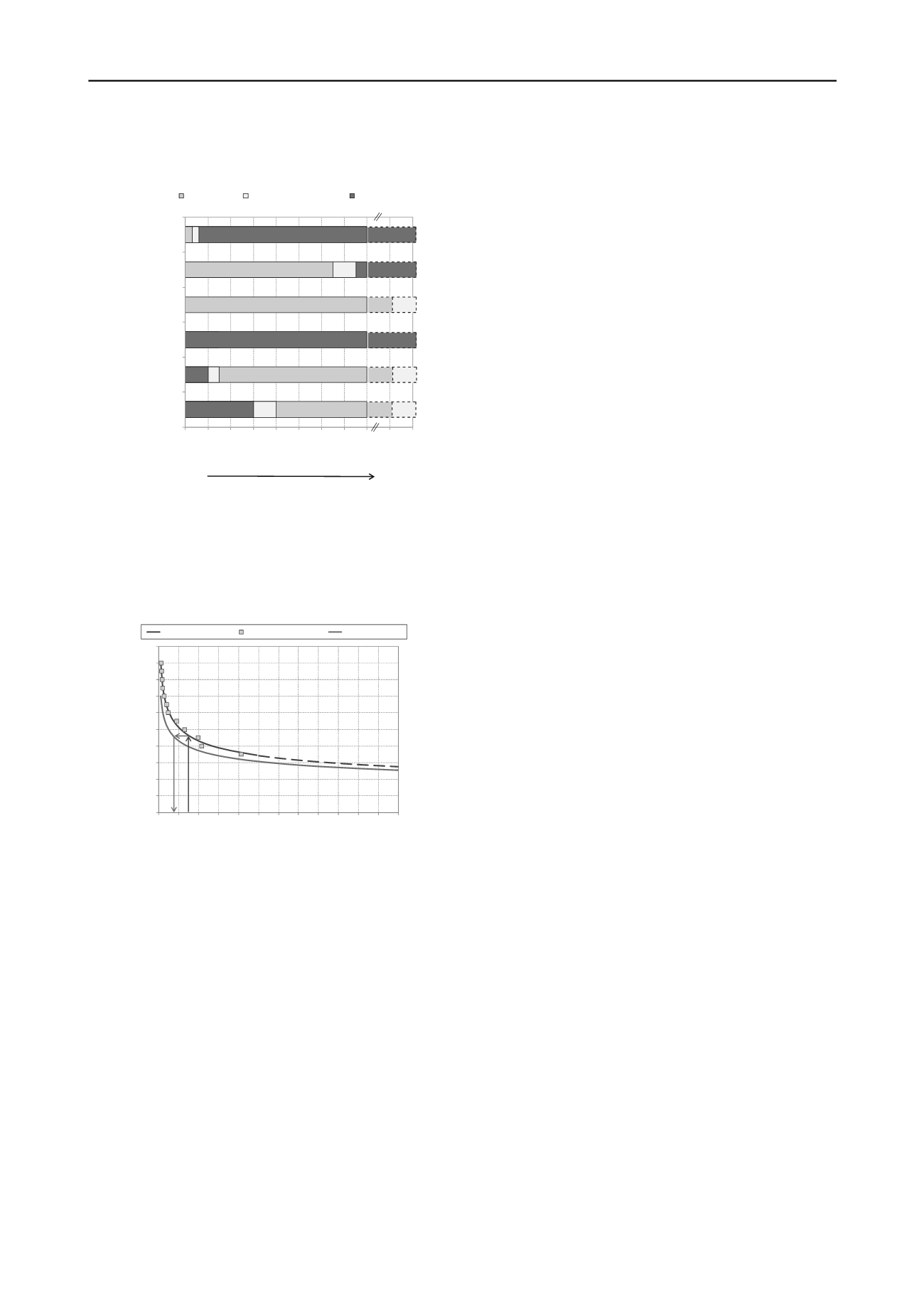
2484
Proceedings of the 18
th
International Conference on Soil Mechanics and Geotechnical Engineering, Paris 2013
applicable, marginally applicable and not applicable. The results
are summarized in the operational abacus of Figure 5.
The results obtained represent a useful data set for the
correct selection of the molding technique for different kind of
soils and mixing conditions headed for the international
standardisation. This study represents a significant step forward
towards the definition of highly required guidelines for the
molding procedures of stabilised soil specimens as used in
QC/QA processes for Deep Mixing applications.
0 10 20 30 40 50 60 70 80 90 100
mixture's workability, Torque
M
t
(Nm)
Molding technique
Applicable MarginallyApplicable NotApplicable
No Compaction
Tapping
Static
Compaction
50kPa
Dynamic
Compaction
Rodding
65 75
10 15
3 6
Static
Compaction
25kPa
30 40
High
workability,
liquid
Low
workability,
consistent
120 ...
5 ACKNOWLEDGEMENTS
The authors wish to thank Prof. Masaki Kitazume for his help
and suggestions throughout the study. The Soil Stabilization
Group of the Port and Airport Research Institute (JP) is also
acknowledged for the helps during the tests and for providing
part of the data.
6 REFERENCES
Al-Tabbaa. A., Liska, M., McGall, R., Critchlow, C. 2012. Soil Mix
Technology for Integrated Remediation and Ground Improvement:
Field Trials. IS-GI Brussels 2012, Belgium.
Figure 5. Ranges of applicability of the different molding techniques.
To allow the standardisation and the use of the method a
“calibration curve” was elaborated by drawing the torque versus
the water content (
w
) of an easily available kind of soil such as
kaolin clay using the set of mixer related parameter V
m0
, S
h0
and
R
s0
(Figure 6).
Bruce, D.A., Bruce, M.E., Di Millio, A.F. 2000. Deep Mixing: QA/QC
and Verification Methods. Grouting Sol Improvement, Geosystems
Including Reinforcement. 4th Intnl Conf. Ground Improvement
Geosystems. Helsinki, Finland, pp. 11-22.
CDIT, Coastal Development Institute of Technology 2002.
The Deep
Mixing Method - principle, design and construction
. A.A. Balkema
Publishers, Lisse, Abingdon, Exton (PA), Tokyo, p. 123.
EuroSoilStab, 2002.
Development of design and construction methods
to stabilise soft organic soils
. Design Guide Soft Soil Stabilization.
EC project BE96-3177, 94p.
Filz, G., Adams, T., Navin, M., Templeton, A.E. 2012. Design of Deep
Mixing for Support of Leeves and Floodwalls. 4th Intnl. Conf. on
Grouting and Deep Mixing, Marriott New Orleans, LA, US.
0
10
20
30
40
50
60
70
80
90
100
0 10 20 30 40 50 60 70 80 90 100 110 120
watercontent,
w
[%]
workability,torque
M
t [Nm]
calibration curve experimentaldata example curve
V
m0
,S
h0
,R
s0
Grisolia M., Kitazume M., Leder E., Marzano I.P., Morikawa Y. 2012.
Laboratory study on the applicability of molding procedures for the
preparation of cement stabilised specimens. IS-GI Brussels 2012,
Belgium
JGS 0821-00 2000.
Practice for Making and Curing Stabilised Soil
Specimens Without Compaction
(Translated version). Geotechnical
Test Procedure and Commentary, Japanese Geotechnical Society.
Kitazume, M., Nishimura, S., Terashi, M., Ohishi, K. 2009.
International Collaborative Study Task 1: Investigation into
Practice of Laboratory Mix Tests as Means of QC/QA for Deep
Mixing Method. International Symposium on Deep Mixing &
Admixture Stabilization, Okinawa, Japan.
V
m
,S
h
, R
s
Koehler, E.P., and Fowler, D.W. 2003.
Summary of Concrete
Workability Test Methods
. Research Report, International Center
for Aggregates Research The University of Texas at Austin.
Figure 6. Calibration curve.
By using different set of parameters (V
m
, S
h
and R
s
),
function of the mixer type and torque evaluation procedure,
other curves can be drawn in the same graph. Therefore for each
molding technique the range of applicability (expressed by
torque values) corresponding to the used set of parameter can be
graphically obtained from the calibration curve, as shown in
Figure 6.
Larsson, S. 2005. State of Practice Report – Execution, monitoring and
quality control. Intnl. Conf. on Deep Mixing - Recent Advances
and Best practice, Stockholm, Sweden.
Marzano I.P., Al-Tabbaa A., Grisolia M. 2009. Influence of sample
preparation on the strength of cement-stabilised clays. Intnl. Symp.
on Deep Mixing & Admixture Stabilization, Okinawa, Japan.
By mean of the abaci of Figures 5 and 6, it would be possible
to select for every kind of mixable soil-binder mixture the
molding technique that gives high quality specimens in a very
quick and easy way only by measuring the workability of the
material.
Marzano I.P., Leder E., Grisolia M., Danisi C. 2012. Laboratory study
on the molding techniques for QC/QA process of a Deep Mixing
work. 3
rd
International Conference on New Developments in Soil
Mechanics and Geotechnical Engineering, Near East University,
Nicosia, North Cyprus. ISBN 975-8359-28-2.
Richards, K. S., Reddy, K. R., 2010. True triaxial piping test apparatus
for evaluation of piping potential in earth structures.
Geotechnical
Testing Journal
, 33(1): 1-13.
Terashi, M. 1997. Deep mixing method Brief state of the art. 14th
International. Conference on Soil Mechanics and Foundation
Engineering. Tokyo
4 CONCLUSIONS
The results of the large laboratory study performed on eight
types of natural soils confirm that the mixture’s “workability”
has a great influence on the mechanical and physical properties
of the stabilised soil specimens. The results provide very useful
operational abaci to select the molding technique that produces
high quality specimens in function of the soil-binder mixture’s
workability.
Terashi, M., and Kitazume, M. 2011. QA/QC for deep-mixed ground:
current practice and future research needs
. Proc. of the Institution of
Civil Engineers – Ground Improvement
164 (3), 161-177.


